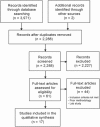The effect of pacifier sucking on orofacial structures: a systematic literature review
- PMID: 29532184
- PMCID: PMC5847634
- DOI: 10.1186/s40510-018-0206-4
The effect of pacifier sucking on orofacial structures: a systematic literature review
Abstract
Background: Non-nutritive sucking habits may adversely affect the orofacial complex. This systematic literature review aimed to find scientific evidence on the effect of pacifier sucking on orofacial structures.
Methods: A search on MEDLINE, EMBASE, Cochrane Central Register of Controlled Trials, and Web of Science databases was conducted to find all pertinent articles published from inception until February 2018, based on the Preferred Reporting Items for Systematic Reviews and Meta-Analyses (PRISMA) guidelines. The quality of the studies was evaluated using the risk of bias judgements in non-randomized studies of interventions (ROBINS-I).
Results: Among the 2288 articles found, 17 articles met the selection criteria: seven prospective cohort studies, nine cross-sectional studies, and one randomized clinical trial. Using ROBINS-I, 12 studies were evaluated to have a serious overall risk of bias and five, a moderate one. These studies claimed a strong association between a pacifier sucking habit and the presence of an anterior open bite and posterior crossbite. Functional/orthodontic pacifiers were shown to cause significantly less open bites than the conventional ones.
Conclusions: High level of evidence of the effect of sucking habits on orofacial structures is missing. The available studies show severe or moderate risk of bias; hence, the findings in the literature need to be very carefully evaluated. There is moderate evidence that the use of pacifier is associated with anterior open bite and posterior crossbite, thus affecting the harmonious development of orofacial structures. Functional/orthodontic pacifiers reduce the prevalence of open bite when compared to the conventional ones, but evidence is needed concerning the effects on posterior crossbite. Well-designed randomized controlled trials are needed to further analyze the effects of functional/orthodontic and conventional pacifiers on orofacial structures.
Keywords: Malocclusion; Non-nutritive sucking habits; Open bite; Orofacial structures; Overjet; Pacifier; Posterior crossbite; Systematic review.
Conflict of interest statement
Ethics approval and consent to participate
Not applicable
Consent for publication
Not applicable
Competing interests
The authors declare that they have no competing interests.
Publisher’s Note
Springer Nature remains neutral with regard to jurisdictional claims in published maps and institutional affiliations.
Figures
References
-
- Callaghan A, Kendall G, Lock C, Mahony A, Payne J, Verrier L. Association between pacifier use and breast-feeding, sudden infant death syndrome, infection and dental malocclusion. Int J Evid Based Healthc. 2005;3(6):147–167. - PubMed
-
- Adair SM. Pacifier use in children: a review of recent literature. Pediatr Dent. 2003;25(5):449–458. - PubMed
-
- Metlinger B. Kinderbüchlein. 1904.
-
- NUK Soothers & Accessories: 2017.http://www.webcitation.org/6qCvCWjov. Accessed 04 May 2017.
Publication types
MeSH terms
LinkOut - more resources
Full Text Sources
Other Literature Sources
Medical
Miscellaneous


